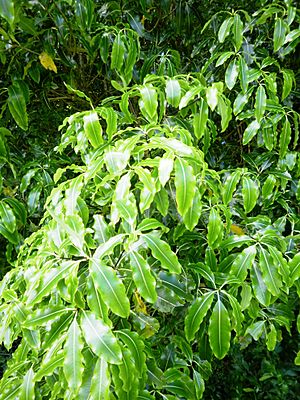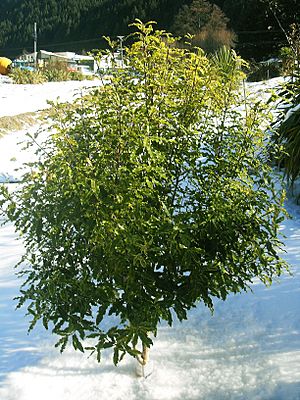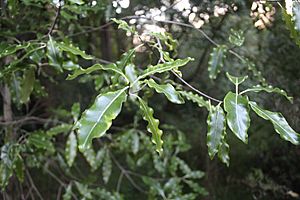Tarata facts for kids
Quick facts for kids Tarata |
|
|---|---|
 |
|
| Scientific classification | |
| Genus: |
Pittosporum
|
| Species: |
eugenioides
|
The Tarata tree, also known as lemonwood, is a special evergreen tree that grows naturally in New Zealand. It's the largest Pittosporum tree found there. This tree can grow up to 12 meters (about 40 feet) tall and 5 meters (about 16 feet) wide. When it's young, it looks like a cone, but as it gets older, it becomes more rounded.
Its leaves are a mix of yellow and green, with wavy edges and a bright line down the middle. If you crush a leaf, it smells strongly like lemons! In spring, it grows beautiful, sweet-smelling yellow-cream flowers. After the flowers, you'll see unique black seed pods. You can find Tarata trees all over New Zealand's North and South Islands. They often grow at the edges of forests and along stream banks, from sea level up to 600 meters (about 2,000 feet) high.
The scientific name eugenioides means "looks like Eugenia", which is another type of plant. There's also a special type of Tarata called 'Variegatum' that has won an award for being a great garden plant.
Contents
Life Cycle of the Tarata Tree
The Tarata tree starts as a small, compact plant. As it grows, it becomes a tall tree with many branches. The lemonwood flowers usually bloom between October and December. The fruit of the lemonwood takes a long time to ripen, about 12 to 14 months. This means you might see both unripe and ripe fruit on the tree at the same time!
Birds and insects help to pollinate the lemonwood flowers. Once the seeds are ready, birds help to spread them around. The seeds of the lemonwood sprout quickly, and new seedlings can appear within a month.
Where Tarata Trees Grow
The Pittosporum eugenioides tree is found only in New Zealand. This is called being "endemic." There are about 200 different types of trees and shrubs in the Pittosporum family. You can find other Pittosporum plants in places like Africa, Australia, some Pacific islands, and parts of Asia. New Zealand's long period of being separated from other lands helped this tree become unique to the country.
Tarata in New Zealand
You can find Pittosporum eugenioides all over New Zealand's South Island and North Island. It grows in low-lying forests, especially in open areas and along the edges of forests, up to 600 meters (about 2,000 feet) above sea level.
Where Tarata Likes to Live
Pittosporum eugenioides prefers cooler, older forests in lowland and subalpine areas across New Zealand. It can grow in both young and old parts of the forest that are regrowing. It's known for being a great plant to quickly create a shady cover, also called a canopy.
Many people are now planting this species, along with other Pittosporum trees, in their home gardens. Plant nurseries and garden centers sell this native tree because it's well-suited to New Zealand's climate, where it has grown for many years. In a garden, the Tarata tree likes sunny or partly shady spots. It doesn't mind the wind and grows best in soil that drains water well.
Growing Tarata Trees
How well lemonwood seeds grow depends on how much moisture is in the soil. If the soil is too wet, the seeds might not grow. The lemonwood, like other Pittosporum trees, can handle some dry weather, so rainfall isn't the most important thing for its survival.
Taking care of P. eugenioides at home is quite easy. It grows well if you water it regularly during the summer. It also likes to be fed with a general tree and shrub fertilizer twice a year, in spring and summer, while it's growing. Trimming the tree also helps it stay healthy, both in gardens and in the wild.
Tarata and Other Living Things
The pittosporum flower weevil (Aneuma rubricale) is a small insect that feeds on the underside of lemonwood leaves. This insect doesn't kill the tree, but it does make holes in the leaves. You can see these holes because the leaf forms a dark brownish-purple ring around them. Only adult weevils live on the lemonwood; their young live on other types of Pittosporum plants.
Common garden pests like aphids and blister scale (psyllids) can also be found on this plant. You can easily control these pests with an insecticide. The best times to spray to prevent them are in February and again in October.
The Lemon Scent of Tarata
The sweet smell of the Tarata flowers suggests that birds who like nectar enjoy visiting this plant for food. Scientists have studied the lemony smell of the leaves to see if the chemicals are the same as those found in other lemon-scented plants, like Verbena. The unique smell of the lemonwood leaves comes from a special mix of scented chemicals in its oil.
Tests found chemicals like Octyl acetae, Terpinen-4-ol, and Decanol. Octyl acetae gives a "fruity, Jasmine, herbaceous aroma." Terpinen-4-ol smells "somewhere between peppermint and pine." Decanol has a "fatty, orange blossom odor." The results showed that this combination of scents in the lemonwood is very unusual for its plant family and different from what you'd find in other citrus-scented plants.
Traditional Uses of Tarata
Cultural Uses by Māori
The Māori people traditionally used the gum, crushed leaves, and flowers of the Tarata for their scent. They often mixed these with plant oils like titoki and kohia.
Māori also used the lemonwood to make hair oils and perfume. For perfume, the oil was mixed with bird fat. The gum from the tree was used to help with bad breath. They would roll the gum into a ball, and it was believed to last a very long time. The gum also made a great glue when chewed.
Using Tarata for Restoration
Pittosporum eugenioides is excellent for creating a shady canopy when restoring natural areas. This shade then allows other plants that like shade to be planted underneath the lemonwood trees later on. It's suggested to plant this species closer together than you might find them in an old forest. Planting them close together makes them grow upwards faster, just like seedlings on a forest floor. P. eugenioides is one of the best plants for this quick canopy growth because it naturally grows fast.
The lemonwood is on the recommended list for replanting "small trees up to 6m" in the design guidelines of the Christchurch City Council. Native plants like the Tarata offer many benefits and are better suited to local conditions compared to plants from other countries.
Tarata in Home Gardens
It's important to include native plants like Tarata in garden designs because they grow well in local conditions. Besides looking good, these plants provide homes for wildlife and create nice spaces for people. They also help filter water runoff.
In a home garden, P. eugenioides is often used as a hedge or a screen. It's a good choice to plant near a swimming pool because it doesn't drop many leaves. It also does well in windy spots and can protect other plants that don't like wind. Its textured leaves clustered together also make a great green background in a garden design.
Images for kids
See also
 In Spanish: Pittosporum eugenioides para niños
In Spanish: Pittosporum eugenioides para niños






